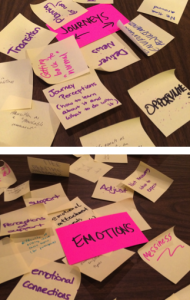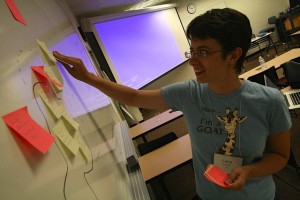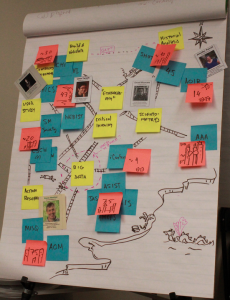Earlier this October, I had the wonderful opportunity be one of the eight thousand women attending the Grace Hopper Conference and Celebration of Women in Computing. I came back home to a lot of questions about some of the press coverage of what happened there. So, here is my take on the good, the bad, and the ugly.
The Good. I always come back from Grace Hopper feeling inspired and energized. Four reasons for it this time… (1) I’m getting to have more opportunities to give back and share advice instead of just asking for it. After a long conversation, an undergraduate woman told me “I’m seriously thinking about grad school now and you’re about 90% of the reason.” Wow! (2) Through the CRA-W, I got to give a talk about “How to Get Your Dream Job” with Jaeyeon Jung. It was probably the largest and definitely the most enthusiastic audience I’ve ever had! (3) It was so inspirational to attend talks by women like Shafi Goldwasser and Megan Smith and Maria Klawe! It’s hard not to go fangirl over this! (4) Last but not least, the dancing. The dancing at Grace Hopper is always amazing! It is totally an experience that every woman in computing should have!
The Bad. Certainly, this year’s Grace Hopper came with quite a bit of controversy: a male allies panel went awry; Microsoft’s CEO said that women shouldn’t ask for raises. And yet, even these issues give me hope for the future. First, yes, the male allies panel had problems: the format shut down discussion (e.g., no Q&A) and the panelists made some very naive statements (see: “how to be a bad ally“). However, many overlook that these men took the feedback to heart and organized an ad-hoc panel the following day where women spoke while the men listened. Second, yes, Nadella did not handle the question about raises well on stage. But, he was there, he apologized right afterwards, and he launched a campaign to address the issues involved. I really believe that the net effect from both of these “bads” is positive. It both draws attention to issues of women in the workplace and makes me optimistic about male allies’ abilities to learn from their own mistakes and make positive changes.
The Ugly. However, one topic that was not well addressed at this year’s conference was the ugliness surrounding GamerGate. It was mostly discussed in the hallways over coffee rather than in any sort of formal way. We need to address this head on. We need to stand with Zoe Quinn and Anita Sarkeesian and Brianna Wu and any other women who face threats and harassment online. I am committing to doing what I can to bring a panel on GamerGate (hopefully with all of these women above) to Grace Hopper next year. Honestly, I have no idea what I am doing on the logistics side (I’ll basically be cold emailing them) [Update: all three women have tentatively agreed]. Also, I am a bit scared to become a target, but if these women can live it, I can brave the small risk. This panel needs to happen. If you have any advice, let me know.




